The Dell XPS 13 (9300) Review: Return of the King
by Brett Howse on July 16, 2020 10:00 AM ESTSystem Performance
When we reviewed the XPS 13 2-in-1 back in November, it was the first device we had tested which featured the new 10 nm Intel Ice Lake platform. At that time, Dell had also recently refreshed the XPS 13, but had outfitted it with the older 14 nm Comet Lake platform. For the all-new XPS 13, Dell has now brought parity to their lineup with Ice Lake here as well, with the improvements that platform brings, especially to the graphics side.
Dell offers three processor options. The least-expensive offering is the Core i3-1005G1, the mid-tier outfitted with the Core i5-1035G1, and the top-tier offering the Core i7-1065G7. Our review unit features the Core i7 model, as Dell wanted to put its best foot forward.
On the memory side, Dell’s spec sheet shows a 4 GB base, although thankfully that is nowhere to be found on their Dell.com site, at least for the USA. Thanks to the move to LPDDR4X with Ice Lake, Dell now offers up to 32 GB of memory on the XPS 13. Storage is all PCIe x4 NVMe, with 256 GB as the base, and a 2 TB maximum.
To see how the XPS 13 performs, we have run it through our newly updated laptop suite. Please not that if a graph does not contain a specific older device, that means that the test has not been run on it. Since the laptops are returned to the manufacturer after review, we cannot do any regression testing for the most part. If you’d like to compare the XPS 13 to any other laptop we have tested, please refer to our Online Bench.
PCMark
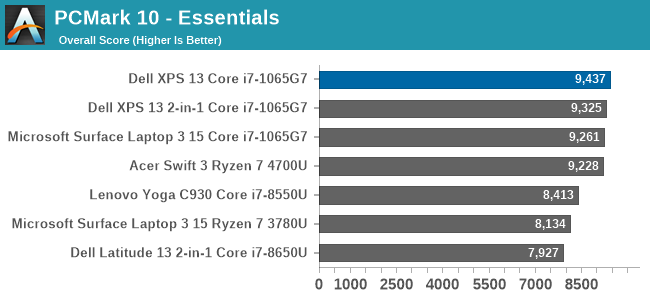
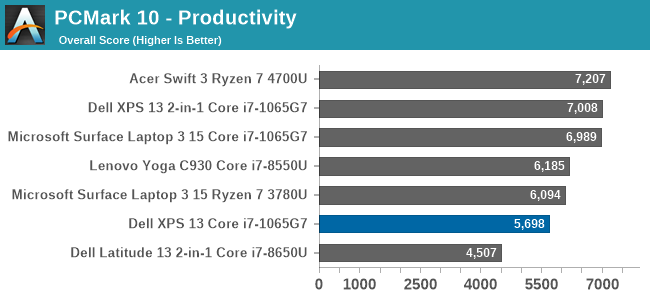
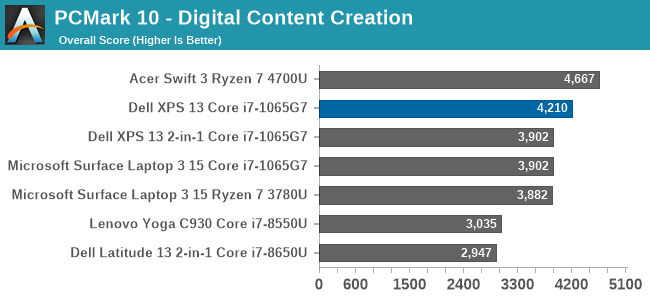
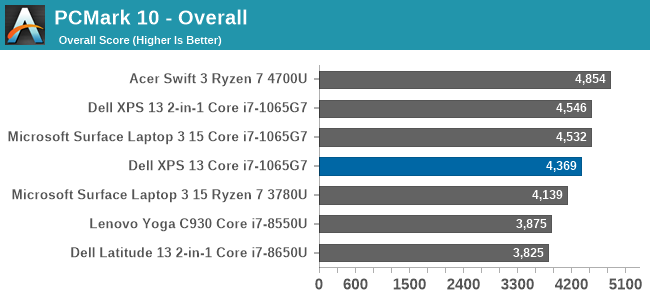
UL’s PCMark 10 is a whole-system benchmark, testing everything from CPU performance to app loading time. The Overall score consists of three categories, each featuring their own unique sub-tests. Overall the XPS 13 scored right in the same ballpark as other Ice Lake notebooks, although was slightly down in the Productivity tests, but slightly ahead in the other two.
Cinebench
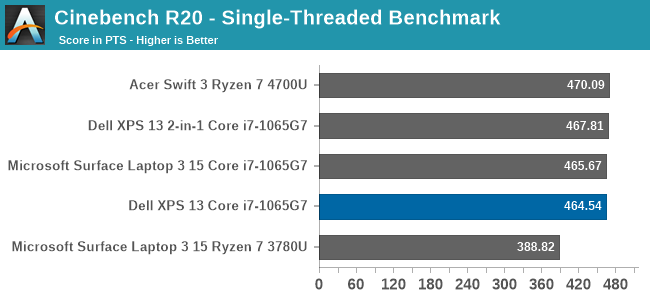
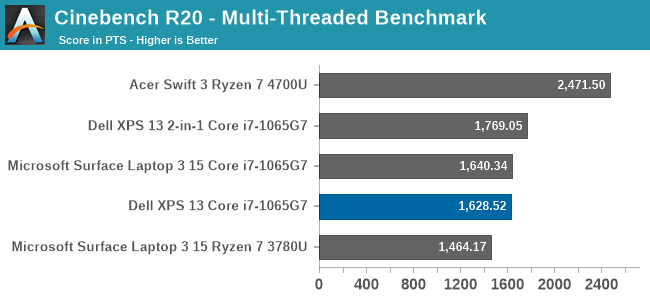
Cinebench, based on Maxon’s Cinema 4D rendering, allows tests of both single-threaded and multi-threaded runs, making it one of the more popular tests for overall computational performance. The XPS 13 does well compared to other Ice Lake equipped notebooks, although with AMD offering up to 8 cores in the same 15-Watt TDP, Intel falls behind in the multi-threaded run.
Handbrake
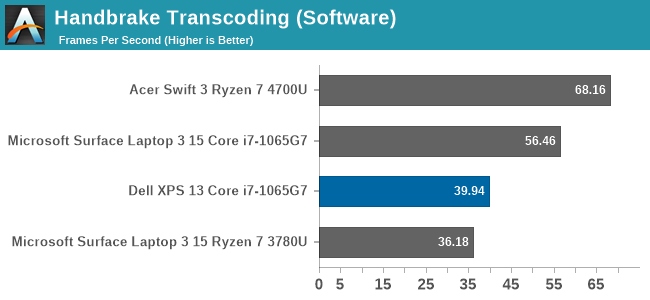
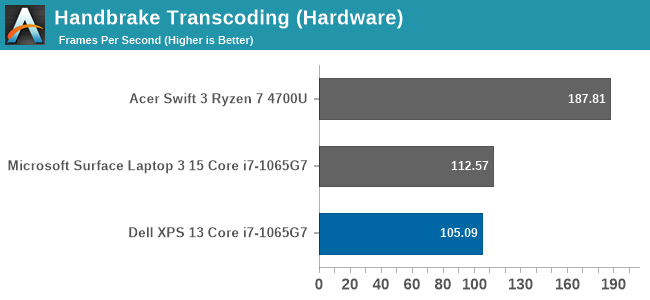
In our Handbrake encoding test, we transcode a 1080p movie to 720p using both software and hardware encoders. Software encoders utilize the CPU, and are generally the preferred method for optimal quality, whereas hardware encoders leverage the media blocks, which in this case is Intel’s QuickSync, for a much faster encode. As we will see more in the thermals section, Dell limits the XPS 13 to a 15-Watt TDP even in its maximum performance mode, where some other manufacturers will allow for higher than listed TDP, up to 20 Watts or so, and as such, the XPS 13 falls a bit behind other Ice Lake notebooks in this test which is TDP limited.
7-Zip


The popular file compression and decompression tool 7-Zip includes a built-in benchmark, and once again the XPS 13 slots right into where other Ice Lake notebooks fit.
Web Tests
Web performance is a function of not only the CPU performance, but also the browser’s scripting engine, and as such we have standardized on the Microsoft Edge browser. Microsoft has now transitioned their browser to the open-source Chromium project. Due to this, we have reset our web tests to use the new Chromium based Edge and taken the opportunity to decommission some of the older tests. We will now focus on Speedometer 2.0 and WebXPRT 3.
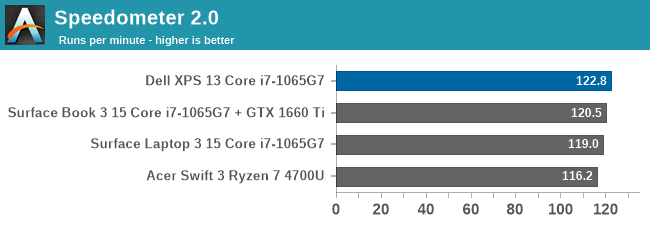
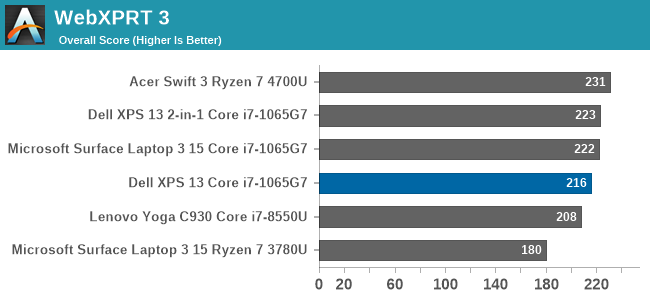
The XPS 13 again slots right in where you would expect for an i7-1065G7 based system.
Storage Performance
Dell offers from 256 GB to 2 TB of PCIe storage, and the review unit was outfitted with the Intel 600p 512 GB drive. We are transitioning to the PCMark 10 storage benchmark, which uses test traces of actual common workloads, such as booting Windows, and many of the Adobe applications, and as such should be a much better indicator of drive performance than just maximum transfer rates.
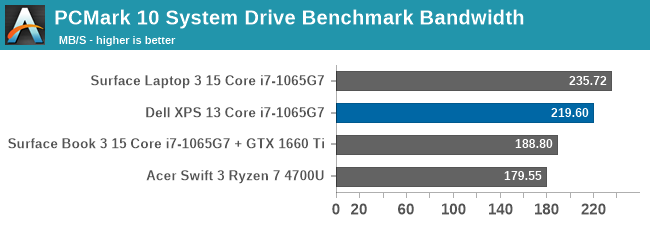
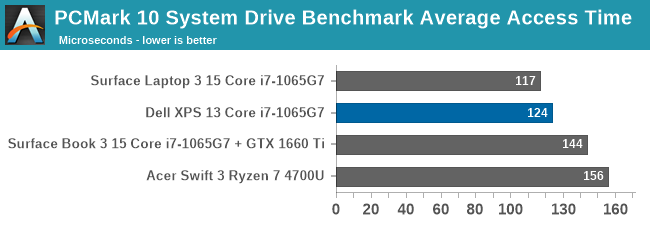

The Intel 600p performs quite well, with good access times and solid bandwidth. Surprisingly, it can’t quite match the excellent performance we saw from the SK Hynix 2230 form factor SSD in the Surface Laptop 3, but almost matches it.











224 Comments
View All Comments
TheinsanegamerN - Thursday, July 16, 2020 - link
If tiger late is as impressive as ice lake the ryzen 4700u will retain a significant advantage in performance, and I'll believe it releases when I see it.Deicidium369 - Thursday, July 16, 2020 - link
Much more impressive. 4C Tiger Lake is 17% slower than 8C Renoir - and Xe LP is at least 2x as fast as Gen11 (in Ice Lake) and performs as well as a Nvidia MX350 (hence why Nvidia is pushing out the Turing MX450) - which wrecks the ancient Vega.So double the cores and a whopping 17% perf advantage - and much slower iGPU - are we sure that AMD understands the laptop market?
rhysiam - Thursday, July 16, 2020 - link
You are doing some gold-standard cherry picking here. Which chart gets you this "17% slower" number you keep quoting as if it's gospel? The 15W thermal envelope is the limiting factor here, so "double the cores" won't net you anywhere near double the performance, nor are they supposed to.According to this very review, lightly threaded tests show the 4700U on par with the similarly clocked Ice Lake. They are neck and neck. IPC is very close between Zen 2 and Sunny Cove.
Highly threaded workloads are dominated by AMD:
CB: 4700U is 52% faster
HB(software): 4700U is 71% faster
HB(hardware): 4700U is 79% faster
7-Zip(comp): 4700U is 34% faster
7-Zip(decomp): 4700U is 40% faster
Remember that the 4700U is **not** the top SKU (though admittedly the 4800U isn't much faster).
Again - where is this "17%" coming from if not deceptively cherry picked?
Tiger Lake looks to have a massive GPU, but what are we looking at CPU wise? A few % IPC and very small clock bump? Maybe Intel squeeze out a tiny single threaded lead, while still getting trashed in multi-core workloads - in exchange for a better iGPU.
Spunjji - Friday, July 17, 2020 - link
@rhysiam - He's basing his claims on an early benchmark leak that does indeed suggest a healthy single-thread lead for Tiger Lake and a moderate multi-core deficit. It doesn't look to be a particularly unreliable leak - apparently comparing like-for-like in terms of chassis - but it's still just the one leak. There are also leaks implying a far less dramatic advantage for the Xe LP GPU, but he's not citing those.When it comes to Deicidium, information suggesting Intel superiority is taken as gospel and information suggesting otherwise is discarded. He spent the months leading up to Renoir's release refusing to believe any of the benchmark leaks favouring AMD and hammering on how unreleased products don't matter. Go figure.
Deicidium369 - Friday, July 17, 2020 - link
Yeah, boy as I wrong - that Great Renoir can compete with an almost year old design! That is unbelievable. With such massive year over year IPC increases - would only be fair to compare the Great Renoir with Alder or Meteor Lake.Too bad AMD marketing never pans out and when the fanboys get it - and filter it through their fever dreams - it is even more disappointing when released - The Another Marketing Deception product release
HYPE HYPE HYPE LAUNCH SIGH! NEXT (or compare to last years outgoing CPU)
Korguz - Friday, July 17, 2020 - link
just like you do as well Deicidium369. so look who's talking, little childByte - Friday, July 17, 2020 - link
I guess competitive means you are still alive in a two horse race. Doesn't matter if your horse overheated on the side of the road.Santoval - Friday, July 17, 2020 - link
If Tiger Lake is still capped at 4 cores (and apparently both the Y and U variants are, though the -H variant will probably have up to 6 cores) it will not be able to compete with AMD's APUs in *CPU* performance. According to some leaks though Tiger Lake's Xe iGPU outperforms the (very) old Vega based iGPU that for some inexplicable reason (to avoid internal competition with their lowest end Navi graphics cards?) AMD decided to add to their 4000 APU series.Well, Xe hasn't even been released yet and Vega was released 3 full years ago, so if Xe couldn't even outclass (barely apparently) a 3-year old iGPU Intel would be in deep trouble. Tiger Lake might outperform AMD's APUs in single thread performance, but that doesn't matter as much anymore. The question is how much Intel managed to raise the IPC and the clocks of Tiger Lake over Ice Lake, but it's not "doubtful" at all that AMD's APUs will be in most ultrabooks by early next year. Only people who were sleeping in a technological cave for the last 3 years would think that.
Deicidium369 - Friday, July 17, 2020 - link
inclusion of Vega was AMD's choice.Ice Lake had a 30% increase in IPC (the quip about, at the expense of lower clocks is meaningless) and with improved 10nm+ and architectural advanced in Willow Cove equate to an actual IPC increase, not just one in marketing materials.
4 cores can easily equal AMD 8 cores. These are ultralights - they are not DTR - 4 superior cores + superior graphics are the best mix - not 8 cores an ancient Vega iGPU.
They won't be in premium devices - it is not their market - Lenovo is as close as they will come - not worth the OEMs to design around a niche APU that won't sell in profitable numbers.
OEMs seem to not want to make the investment into AMD designs, no one is asking for them, and they have no advantage over the well established, steady (Intel never dropped out of sight for more than a decade) and reliable Intel.
MOAR COARZ. LMAO.
Korguz - Friday, July 17, 2020 - link
lets see you post proof of this, Deicidium369. if not, its just your usual pro intel, anti amd bs, as you always post.